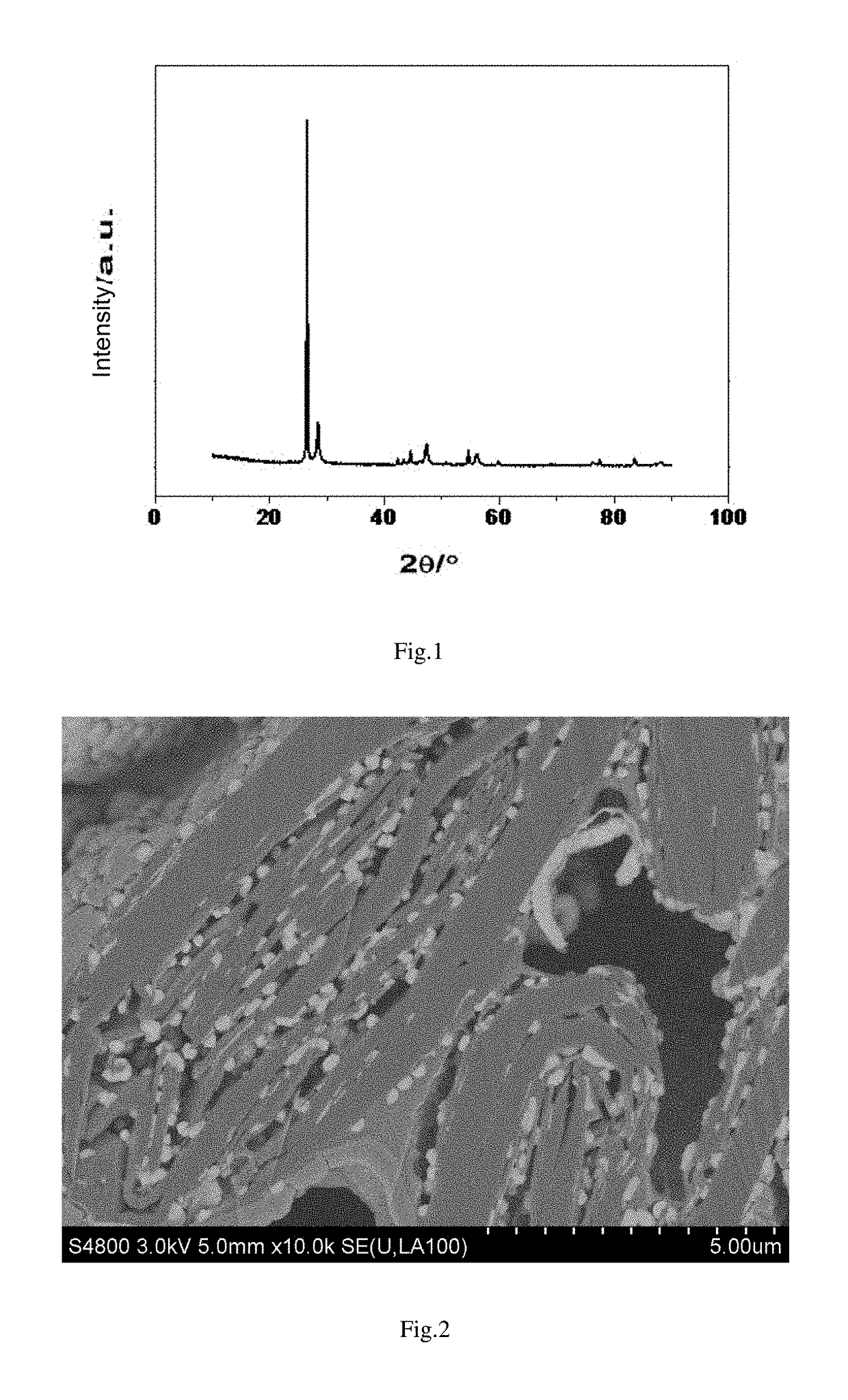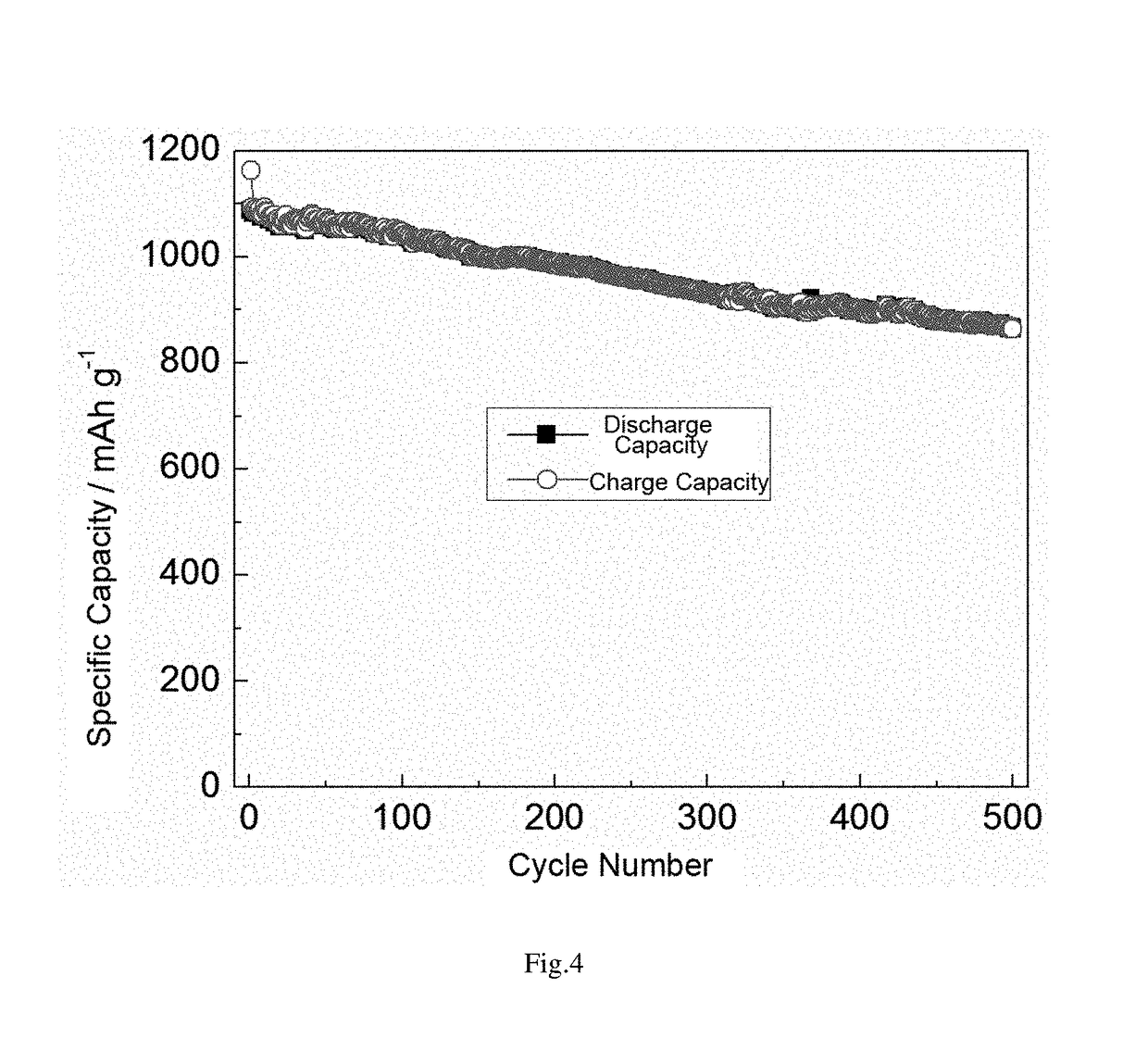Nano-silicon composite negative electrode material used for lithium ion battery, process for preparing the same and lithium ion battery
a technology of negative electrode material and nano-silicon, which is applied in the field can solve the problems of certain distance between these systems and practical levels, inability to meet the demand of lithium ion batteries on high-energy density, and uneven distribution of nano-silicon
- Summary
- Abstract
- Description
- Claims
- Application Information
AI Technical Summary
Benefits of technology
Problems solved by technology
Method used
Image
Examples
example 1
[0050](1) 500 g of natural spherical graphite powder having an average particle size of 16-19 μm and having a carbon content of 99.95% and 1 L of water were added into a ball milling tank and homogeneously stirred. Then 4 kg of zirconia balls having a diameter of 10 mm were added. The ball mill had a rotate speed of 480 r / min. After ball milling for 5-25 h, extraction filtration and drying were carried out to obtain hollowed graphite material having a particle size of 1.0 μm;
[0051](2) 500 g of the hollowed graphite was placed in a rotary furnace. The rotating speed was adjusted to 0.5 r / min After increasing the temperature at a rate of 5.0° C. / min to 700° C. under the protection of high-purity nitrogen having a flow rate of 1.0 L / min, high-purity nitrogen was changed to a gas mixture of high-purity hydrogen and SiHCl3, wherein the flow rate was maintained at 10.0 L / min. After maintaining the temperature for 3.0 h, the gas was changed to high-purity nitrogen, then naturally cooled to...
example 2
[0057](1) 500 g of synthetic graphite powder having an average particle size of 10-13 μm and having a carbon content of 99.95% and 1 L of water were added into a ball milling tank and homogeneously stirred. Then 3 kg of zirconia balls having a diameter of 5 mm were added. The ball mill had a rotate speed of 800 r / min After ball milling for 25-40 h, extraction filtration and drying were carried out to obtain hollowed graphite material having a particle size of 8.0 μm;
[0058](2) 500 g of the hollowed graphite was placed in a rotary furnace. The rotating speed was adjusted to 2.0 r / min After increasing the temperature at a rate of 3.0° C. / min to 700° C. under the protection of high-purity nitrogen having a flow rate of 1.0 L / min, high-purity nitrogen was changed to a gas mixture of high-purity hydrogen and SiH4, wherein the flow rate was maintained at 2.0 L / min After maintaining the temperature for 0.5 h, the gas was changed to high-purity nitrogen, then naturally cooled to room tempera...
example 3
[0061](1) 500 g of natural spherical graphite powder having an average particle size of 16-19 μm and having a carbon content of 99.95% and 1 L of water were added into a ball milling tank and homogeneously stirred. Then 4 kg of zirconia balls having a diameter of 3 mm were added. The ball mill had a rotate speed of 800 r / min After ball milling for 40-60 h, extraction filtration and drying were carried out to obtain hollowed graphite material having a particle size of 5.0 μm;
[0062](2) 500 g of the hollowed graphite was placed in a tub furnace. The rotating speed was adjusted to 0.5 r / min After increasing the temperature at a rate of 5.0° C. / min to 1000° C. under the protection of high-purity nitrogen having a flow rate of 2.5 L / min, high-purity nitrogen was changed to a gas mixture of high-purity hydrogen and SiCl4, wherein the flow rate was maintained at 10.0 L / min After maintaining the temperature for 8.0 h, the gas was changed to high-purity nitrogen, then naturally cooled to room...
PUM
| Property | Measurement | Unit |
|---|---|---|
| particle size | aaaaa | aaaaa |
| particle size | aaaaa | aaaaa |
| particle size | aaaaa | aaaaa |
Abstract
Description
Claims
Application Information
 Login to View More
Login to View More - R&D
- Intellectual Property
- Life Sciences
- Materials
- Tech Scout
- Unparalleled Data Quality
- Higher Quality Content
- 60% Fewer Hallucinations
Browse by: Latest US Patents, China's latest patents, Technical Efficacy Thesaurus, Application Domain, Technology Topic, Popular Technical Reports.
© 2025 PatSnap. All rights reserved.Legal|Privacy policy|Modern Slavery Act Transparency Statement|Sitemap|About US| Contact US: help@patsnap.com



